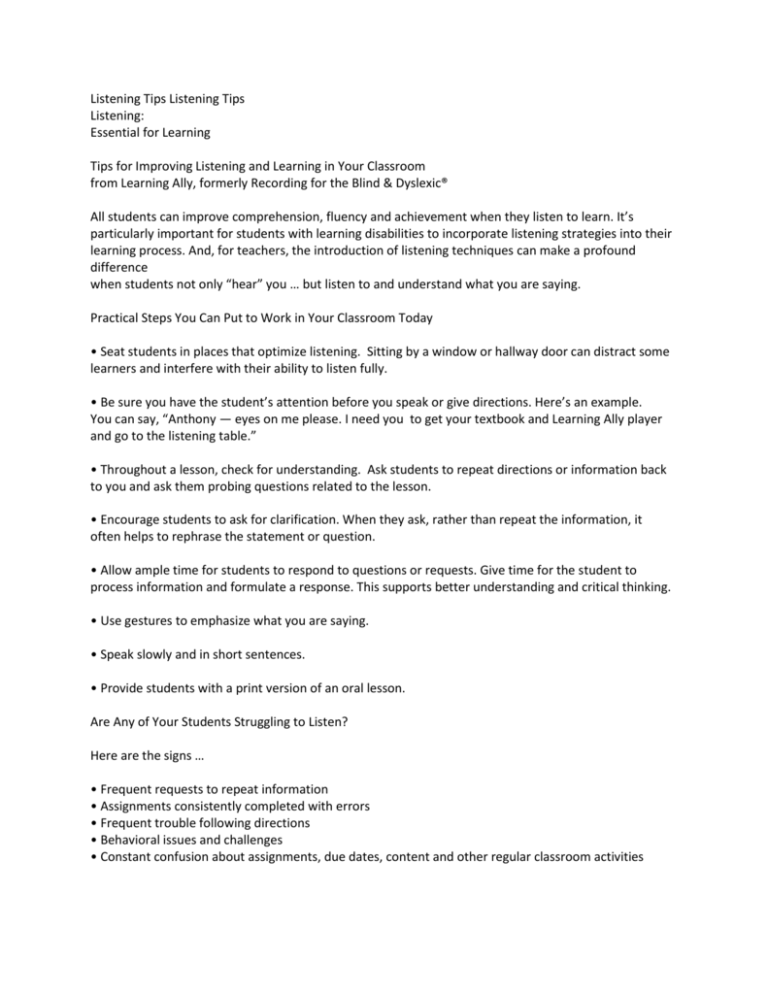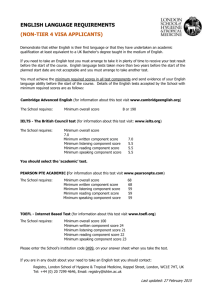
Listening Tips Listening Tips
Listening:
Essential for Learning
Tips for Improving Listening and Learning in Your Classroom
from Learning Ally, formerly Recording for the Blind & Dyslexic®
All students can improve comprehension, fluency and achievement when they listen to learn. It’s
particularly important for students with learning disabilities to incorporate listening strategies into their
learning process. And, for teachers, the introduction of listening techniques can make a profound
difference
when students not only “hear” you … but listen to and understand what you are saying.
Practical Steps You Can Put to Work in Your Classroom Today
• Seat students in places that optimize listening. Sitting by a window or hallway door can distract some
learners and interfere with their ability to listen fully.
• Be sure you have the student’s attention before you speak or give directions. Here’s an example.
You can say, “Anthony — eyes on me please. I need you to get your textbook and Learning Ally player
and go to the listening table.”
• Throughout a lesson, check for understanding. Ask students to repeat directions or information back
to you and ask them probing questions related to the lesson.
• Encourage students to ask for clarification. When they ask, rather than repeat the information, it
often helps to rephrase the statement or question.
• Allow ample time for students to respond to questions or requests. Give time for the student to
process information and formulate a response. This supports better understanding and critical thinking.
• Use gestures to emphasize what you are saying.
• Speak slowly and in short sentences.
• Provide students with a print version of an oral lesson.
Are Any of Your Students Struggling to Listen?
Here are the signs …
• Frequent requests to repeat information
• Assignments consistently completed with errors
• Frequent trouble following directions
• Behavioral issues and challenges
• Constant confusion about assignments, due dates, content and other regular classroom activities
When students struggle to listen, there may be a physical problem affecting hearing or auditory
processing. Teachers can support all learners by incorporating listening strategies into instruction.
Empower Students with Listening Skills
Share these tips and techniques with students so they can build independent listening skills:
• Give the speaker your full attention. Practice tuning out distractions such as looking out
the window or hallway.
• Focus your mind on what the speaker is saying.
• Wait until the speaker is done before adding your thoughts
• Listen and absorb everything being said. Wait to respond until you’ve heard the
entire message.
• Listen for the main idea. It’s often stated at the beginning and/or the end of a lecture
or presentation.
• Ask questions to help clarify the concept or subject.
• Smiling or nodding your head while someone speaks lets them know you’re listening and
comprehending.
Make Listening Part of Your Teaching Strategies and Watch Students Improve!
Here are some strategies to consider when planning instruction:
• Identify the obstacles to listening in your classroom and work to mitigate or remove them.
• Provide direct instruction in listening strategies and integrate them into your lessons.
• Use visual reinforcement and post the strategy in your classroom.
• Give students ample opportunities to practice listening across curriculum.
• Share strategies with parents to help reinforce them at home.
• When applicable, include listening strategies in students’ Individualized Education Plans (IEPs).
Quick facts about listening from the International Listening Association:
• Confident people tend to listen to content better than unconfident people.
• How much of what we know have we learned by listening? 85%
• What percentage of the time are we distracted, preoccupied or forgetful? 75%
• How much do we usually recall immediately after we listen to someone talk? 50%
• What percentage of time do we spend listening? 45%
• How much do we remember of what we hear? 20%
• What percentage of the population has had formal educational experience
with listening? Less than 2%
• We listen at 125-250 words per minute, but think at 1,000-3,000 words per minute.
For Additional Information about Learning Ally’s programs, membership, teacher training and other
services, contact our Membership Specialists at 866-732-3585.
©2011 Learning Ally, Inc. All rights reserved. Learning Ally™, Making reading accessible for all™, the
“Access” icon, Recording for the Blind & Dyslexic®, RFB&D® and all trademarks and service marks are
owned by Learning Ally, Inc.







